The Current Status of Round-Up in Agriculture


Intro
The use of Round-Up, a widely recognized herbicide, has spurred various discussions within the agricultural community. Understanding its market status and relevance today is crucial. This article aims to dissect the key factors shaping Round-Up's position in agriculture. We will consider its historical background, market dynamics, and the shifting perceptions of consumers toward its use.
Key Concepts and Terminology
Basic Definitions
Round-Up is a brand of herbicide that contains glyphosate as its active ingredient. It primarily functions to control broadleaf weeds and grasses that compete with crops in farming. Glossing over technical terms, glyphosate disrupts essential plant processes, leading to weed death while allowing crops to thrive.
Historical Context
Since its introduction in the 1970s, Round-Up has gained significant traction among farmers for its effectiveness and ease of use. It revolutionized weed management, marking the transition to no-till farming practices. Over the decades, its use has evolved alongside the rise of genetically modified organisms (GMOs) that are resistant to glyphosate. However, with increasing scrutiny on pesticide use and regulatory issues, Round-Up's status has come under fire in recent years.
Recent Innovations and Trends
Technological Advancements
The agricultural sector has embraced new technologies, aimed at improving efficiency and reducing environmental impacts. Innovations like precision agriculture tools allow farmers to utilize herbicides more effectively. These technologies enable targeted herbicide application, minimizing waste and enhancing precision in weed control.
Sustainable Practices
Amid rising environmental consciousness, farmers are exploring sustainable farming practices. These include crop rotation, intercropping, and organic methods that reduce reliance on chemical herbicides. This shift is not only a response to regulatory pressures but also consumer demand for sustainable agriculture products.
Practical Applications and Techniques
Step-by-step Guides
- Understand Your Weed Issues: Identify the specific weeds affecting your crops.
- Select Appropriate Products: Research suitable herbicides like Round-Up and alternatives.
- Implement Precision Techniques: Employ technology to apply herbicides efficiently.
- Monitor Outcomes: Evaluate effectiveness and make necessary adjustments.
Case Studies
Several farmers in the Midwest have successfully integrated sustainable practices with traditional Round-Up use. By alternating crops and introducing cover crops, they report weed reduction while maintaining yield. This balance showcases adaptive strategies within a changing market landscape.
"Farmers must navigate a complex environment of regulations, consumer demand, and technological change to remain relevant today."
Intro to Round-Up
Understanding Round-Up is critical for multiple stakeholders in the agricultural domain. This herbicide, containing glyphosate as its active ingredient, has been a mainstay since its introduction. Its significance lies in its widespread application for effective weed control, which in turn aids in higher crop yields. As farmers face increasing challenges related to competition and environmental concerns, comprehending how Round-Up fits into their practices becomes imperative.
Historical Background
Round-Up was first developed by Monsanto in the 1970s. Initially, it was marketed for its broad-spectrum efficacy against various weeds. Its mode of action targets a specific enzyme pathway that is found in plants and some microorganisms but absent in humans and animals. Over the decades, Round-Up gained a strong foothold in agriculture, becoming synonymous with glyphosate-based herbicides. Its popularity surged as farmers sought reliable solutions for weed management in various cropping systems.
However, the history of Round-Up is not without controversy. As early studies linked glyphosate to potential health risks, public perception began to shift. Regulatory bodies scrutinized its use as consumer awareness grew regarding the environmental and health implications associated with chemical herbicides.
Composition and Mechanism of Action


Round-Up consists primarily of glyphosate, along with other adjuvants. Glyphosate is a systemic herbicide that works by inhibiting a specific enzyme pathway, the shikimic acid pathway. This pathway is crucial for the synthesis of key amino acids needed for plant growth, thus leading to the death of targeted weeds.
The formulation of Round-Up also includes surfactants, which enhance its effectiveness by improving its absorption. This feature is particularly useful in applications where weeds may be otherwise resistant to treatment.
The effectiveness of Round-Up has been demonstrated across a range of crops, including corn, soybeans, and cotton. Its use is well-embedded in modern agricultural practices, offering farmers a tool for better yield outcomes.
Despite its efficacy, ongoing debates around glyphosate's safety and environmental impact have compelled some growers to reconsider reliance on Round-Up. Awareness around the short- and long-term implications of synthetic herbicides is reshaping farming practices globally.
Round-Up's Market Presence
The market presence of Round-Up is a crucial aspect of understanding its role within the agricultural sector. Not only does it reflect the product's significance and acceptance among farmers, but it also outlines how social, economic, and regulatory factors shape its utilization. Examining Round-Up's market presence provides valuable insights into the current agricultural practices and consumer preferences, allowing stakeholders to make informed decisions. This section will delve into two prominent elements: current sales and market share, along with the distribution channels that affect its reach.
Current Sales and Market Share
Round-Up has maintained a prominent position in the herbicide market for several decades. Its sales figures elucidate the brand's stronghold on farmers who rely on it for effective weed control. In recent years, Round-Up has captured approximately 40% of the global herbicide market. Despite the recent controversies and legal challenges related to glyphosate, market data indicates a consistent sales performance, demonstrating a resilient demand in diverse agricultural contexts.
The product appeals to a wide range of users, spanning large commodity growers to small-scale farmers. Understanding the demographics of Round-Up users sheds light on its market strategy. Many farmers report that the effectiveness of Round-Up in managing resistant weed species is a key reason for its continued preference over competing products.
Additionally, the brand’s sales volume highlights a shift in user habits. Organic farming methods see rising popularity but currently represent a smaller segment of the market—suggesting that products like Round-Up still play a central role for many producers, particularly in conventional crops.
Distribution Channels
The distribution framework of Round-Up is complex, involving a network that extends from manufacturers to end-users. The majority of Round-Up products are sold through agricultural retailers, cooperatives, and specialized online platforms.
- Agricultural Retailers: These are often local stores where farmers can access a variety of farming needs, including herbicides. Retailers provide not just the product, but also advice and support tailored to specific crops and regional challenges.
- Cooperatives: Many farmers belong to cooperatives that offer collective purchasing options. Round-Up is frequently listed as a key product due to its widespread effectiveness.
- Online Platforms: The surge in e-commerce has not spared the agricultural sector. Farmers increasingly turn to online channels for convenience and competitive pricing, and Round-Up's availability on platforms like Amazon complements traditional retail methods.
Understanding how Round-Up reaches its audience highlights the influence of both retail trends and the evolving purchasing behaviors of farmers. As farmers adapt to new methods and technologies, the distribution channels' efficiency in delivering Round-Up will be a crucial factor in sustaining its market presence.
Regulatory Landscape
The regulatory landscape surrounding Round-Up is essential for understanding its market presence and future viability. Regulations impact not only how Round-Up is produced and marketed but also how farmers view its application. With ongoing health and environmental debates, these regulations must balance public safety with agricultural efficiency. Compliance with regulatory standards allows manufacturers to ensure that their products are safe and effective. Understanding regulations helps farmers make informed decisions regarding pest management while adhering to industry standards.
Global Regulatory Standards
Global regulatory standards for glyphosate, the active ingredient in Round-Up, vary significantly by region. In the United States, glyphosate is regulated by the Environmental Protection Agency (EPA). The agency has established tolerance levels for glyphosate residues on food and has affirmed its use as safe when applied according to label instructions. However, the European Union has adopted a more cautious approach, with strict regulations aimed at protecting human health and the environment. Various EU member states have implemented bans or severe restrictions on glyphosate use, reflecting a growing concern about its health implications.
In addition, global bodies such as the World Health Organization (WHO) and the Food and Agriculture Organization (FAO) have issued guidelines and assessments regarding glyphosate's safety. Their comprehensive analysis often informs national regulations, leading to changes in how glyphosate can be used in agriculture. The divergence in global standards underscores the complex interplay between agricultural practices and regulatory frameworks.
Recent Legislation Changes
Recent changes in legislation have significantly affected the use and perception of Round-Up in various markets. In 2020, the state of California mandated that manufacturers include warnings on products containing glyphosate, following legal rulings that highlighted the potential cancer risk associated with exposure. This move has raised public awareness and altered purchasing behavior among consumers, with some opting for alternatives viewed as safer.
In the European Union, new legislative proposals have emerged that aim to further restrict glyphosate use. As public sentiment shifts towards sustainability, several countries are reevaluating their stance on glyphosate, leading to discussions of total bans in some areas. These changes in legislation significantly affect farmers’ operational choices, inviting them to explore alternate methods for weed management, which may not always be as effective as Round-Up.
"Legislative changes reflect broader societal concerns, pushing agriculture towards more sustainable practices."
The implications of such regulations and legislation emphasize the ongoing struggle between agricultural needs and public health concerns. As stakeholders adapt, the market dynamics surrounding Round-Up will likely continue to evolve.
Public Perception and Controversies


Understanding public perception and the controversies surrounding Round-Up is crucial for comprehending its market presence. The herbicide has not only influenced agricultural practices but has also stirred debates that impact consumer choices and regulatory actions. As awareness of health and environmental issues grows, the scrutiny on Round-Up intensifies. This section examines the health concerns associated with glyphosate, its primary ingredient, and the environmental effects attributed to its widespread use.
Health Concerns Associated with Glyphosate
Glyphosate, the active component in Round-Up, has been at the center of numerous health-related discussions. Many studies and articles have raised questions about its carcinogenic potential. The International Agency for Research on Cancer classified glyphosate as "probably carcinogenic in humans" based on sufficient evidence in animal studies. Consumers now often weigh the risks versus benefits of using products containing glyphosate.
Farmers and agricultural professionals may find themselves caught in a dilemma. While glyphosate offers effective weed control, fears about its long-term health effects can create reluctance among consumers. Additionally, there are mounting lawsuits from individuals alleging health issues due to glyphosate exposure, further intensifying public concern and debate. These issues compel stakeholders to stay informed about both scientific findings and public sentiment, which are ever-changing.
Environmental Impact
Beyond human health, glyphosate's environmental impact raises a significant alarm. Studies have shown its effect on biodiversity and ecosystem health. For instance, glyphosate is known to affect non-target species, including beneficial insects and plants. This has led to a decline in pollinator populations, which are vital for crop production.
Also, the overuse of glyphosate can contribute to herbicide-resistant weed populations. This phenomenon puts additional pressure on farmers, often pushing them to utilize even more chemicals or alternative, sometimes harmful methods.
"With increasing environmental scrutiny, producers must consider not just yield, but the broader impact of their practices on soil health and biodiversity."
Join the discussion on platforms like reddit.com to gain insight into community concerns and share experiences.
Overall, the public perception of Round-Up is shaped by health risks, environmental implications, and an evolving regulatory landscape. Understanding these complexities is essential for stakeholders navigating the agricultural industry's future.
Market Alternatives
In an era where agricultural practices are under scrutiny, the exploration of market alternatives to Round-Up has become crucial. Farmers and agricultural enthusiasts are increasingly looking for options that align with sustainable practices while still addressing weed management effectively. The shift towards these alternatives is not solely driven by regulatory pressures but also by changing consumer preferences and environmental concerns. The alternatives primarily focus on reducing chemical input, fostering biodiversity, and ensuring the long-term health of soil and ecosystems.
Organic Herbicides
Organic herbicides are gaining traction as a potent alternative to traditional chemical weed killers like Round-Up. These products are derived from natural substances, offering achemical-free option that appeals to health-conscious consumers and eco-friendly farming methods. Organic herbicides, such as those made from vinegar or essential oils, often target specific weed species, making them less harmful to beneficial plants.
The benefits of organic herbicides extend beyond safety. They can improve soil health and support the ecological balance by promoting microbial activity and reducing potential harmful residues in the environment. However, it is essential to consider their effectiveness and application timing, as they may require more frequent applications compared to synthetic herbicides. Furthermore, farmers may need to adapt their weed management strategies, merging traditional and organic approaches for best results.
Integrated Pest Management
Integrated Pest Management (IPM) represents a holistic strategy that encompasses various methods to control weeds and pests without relying heavily on one single approach. This method emphasizes the importance of understanding the ecosystem, involving biological, cultural, mechanical, and chemical practices to create a balanced system.
One of the core principles of IPM is monitoring and identifying problems accurately to implement targeted solutions. For farmers, this means assessing the specific needs of their crops, identifying weed species, and applying the most effective treatment without over-reliance on herbicides. Implementing IPM can lead to a decrease in the overall pesticide burden and an increase in biodiversity on farms.
"By shifting to Integrated Pest Management, farmers can reduce chemical dependency and create resilient agroecosystems."
The integration of diverse control methods improves the sustainability of agricultural practices while addressing the concerns raised by using substances like glyphosate. However, the transition to IPM requires education, training, and planning, which can be a challenge for many farmers.
Consumer Trends and Expectations
Understanding consumer trends and expectations is essential in analyzing the current market status of Round-Up. As societal values evolve, farmers and agricultural businesses need to keep pace with changing consumer demands. The shift towards more sustainable practices and a call for transparency deeply influences purchasing decisions in the agriculture sector. This section explores these two critical trends in detail.
Shift Towards Sustainable Practices
The increasing awareness of environmental issues has led consumers to favor sustainable agricultural practices. Sustainable farming aims to meet society's current food needs without compromising future generations. This concept has seen rising support from various stakeholders, including consumers, retailers, and policymakers. Farmers who adopt sustainable methods often benefit from enhanced brand loyalty and consumer trust. In many instances, this loyalty translates into financial success.


Consumers are now more inclined to buy products that come from sustainable sources. They expect farmers to minimize environmental impacts, reduce chemical inputs, and produce food that is not only safe but also ethically sourced. Consequently, Round-Up and other glyphosate-based herbicides are facing scrutiny regarding their environmental effects. The pressure to utilize sustainable alternatives is mounting.
Besides, companies are increasingly marketing their commitment to sustainability. They showcase their efforts to reduce reliance on synthetic chemicals, searching for organic options or integrated pest management strategies. This trend underscores the need for transparency regarding product sourcing. Brands that fail to adjust may risk losing market share.
"Sustainability is no longer a choice but a necessity. Farmers and brands that adapt will likely thrive in the evolving market landscape."
Demand for Transparency
As consumers become more informed, the demand for transparency in agricultural practices intensifies. Transparency involves providing information about how products are grown, processed, and distributed. This demand is driven by a desire for safety, ethical considerations, and environmental consciousness. Consumers are not just interested in the final product; they want to understand its journey from farm to table.
For Round-Up, the implications are significant. Farmers using glyphosate must communicate clearly about their practices and the safety measures in place. The perceived risks associated with chemical usage can deter potential buyers. Providing factual data about the herbicide's application rates, safety for food crops, and any environmental monitoring efforts are critical aspects of creating transparency.
Moreover, retailers and agricultural cooperatives are also integrating transparency into their business models. They may implement traceability systems, allowing consumers to track produce back to specific farms or practices. This shift can enhance trust and customer loyalty, fostering a positive image of brands that embrace transparency.
In summary, as consumer expectations around sustainability and transparency grow, Round-Up's market presence will likely be affected. The agricultural industry must navigate these trends responsibly, balancing profitability with ethical practices. By effectively addressing these consumer demands, farmers can maintain market relevance and meet the evolving expectations of their customers.
The Future of Round-Up in Agriculture
The future of Round-Up in agriculture is a subject of considerable relevance, especially in light of the evolving market dynamics and consumer expectations. As an established herbicide, Round-Up has been a preferred choice among farmers for its efficacy in weed control. However, various factors are influencing its standing in the agricultural sector. These include regulatory developments, shifting public perceptions, and increased competition from alternative products. Understanding the future trajectory of Round-Up is essential for farmers and industry stakeholders to navigate these changing landscapes.
Potential Market Adjustments
In the coming years, Round-Up may need to adapt to various market adjustments. These shifts arise from both external pressures and internal evaluations of the product's viability. Key elements influencing these adjustments include:
- Regulatory Changes: As countries and regions reassess glyphosate use, Round-Up's sales may fluctuate significantly. New regulations could impose stricter application guidelines or even lead to bans in specific markets.
- Consumer Preferences: The farmer's choice of herbicides is increasingly influenced by end-consumers who demand sustainable practices. An uptick in organic farming can impact the demand for Round-Up.
- Pricing Strategies: As competition rises from organic alternatives, Round-Up's pricing structure may need reevaluation to remain attractive to farmers.
- Technological Advances: New formulations or application techniques could enhance efficacy, which might influence market interest and adoption rates among users.
"Adapting to market changes is not optional; it is a necessity for survival in agriculture."
Role in Sustainable Farming
Despite the controversies surrounding glyphosate and Round-Up, the product could still play a significant role in sustainable farming strategies. Here are several considerations:
- Integrated Weed Management: Round-Up can be used in combination with other practices, assisting farmers in reducing herbicide resistances and promoting biodiversity. It is critical for farmers to integrate it as part of a broader management strategy.
- Reduced Soil Disturbance: With no-till farming practices, Round-Up contributes to minimizing soil erosion. This farming method encourages carbon sequestration, enhancing soil health while controlling weed populations effectively.
- Effectiveness: By maintaining efficient weed control, Round-Up allows farmers to achieve higher yields, mitigating the need for frequent inputs and labor. This effectiveness can contribute to the overall efficiency required in sustainable agricultural systems.
In summary, the future landscape for Round-Up within agriculture is shaped by several compelling factors. Understanding these potential market adjustments and the nuanced role it plays in sustainable practices will be crucial for agriculture stakeholders navigating the path ahead.
Culmination
The conclusion of this article serves as a pivotal element to synthesize insights gained throughout the analysis of Round-Up's current standing in the agricultural market. Understanding the nuances of Round-Up’s market presence involves grasping the interplay between historical context, regulatory frameworks, and public perceptions. Each of these layers contributes to a multifaceted understanding of how Round-Up operates today.
Summary of Findings
Throughout this examination, several key findings emerged:
- Market Dynamics: Round-Up retains a significant share in the herbicide market despite increasing scrutiny and legislative changes concerning glyphosate.
- Consumer Sentiment: A marked shift in consumer preferences towards sustainable agricultural practices and increased transparency from manufacturers indicates a changing landscape.
- Alternatives and Adaptation: The rise of organic herbicides and integrated pest management techniques presents formidable competition, pushing traditional products to innovate and adapt.
- Regulatory Considerations: Ongoing global regulatory adjustments necessitate that stakeholders remain agile as new policies emerge, shaping the future of herbicide usage.
The collective understanding of these points provides stakeholders with insight into where Round-Up fits in modern agriculture and how it can evolve in a rapidly changing environment.
Recommendations for Stakeholders
For stakeholders navigating the current market dynamics of Round-Up, the following recommendations are crucial for future planning and adaptation:
- Adapt to Changing Consumer Preferences: Engage with consumers to understand their needs and adjust marketing strategies to emphasize sustainability.
- Invest in Alternative Solutions: Explore and invest in the development of alternatives that align with organic practices, ensuring a wider product range that fulfills varying consumer desires.
- Collaborate with Regulatory Bodies: Maintain proactive communication with regulatory entities to predict changes in legislation and adjust practices accordingly.
- Enhance Transparency: Provide clear and comprehensive information regarding product safety and environmental impacts to build trust and encourage informed consumer decisions.
By considering these points, stakeholders can better position themselves to thrive in an increasingly complex agricultural market while addressing the concerns of both consumers and regulatory bodies.















